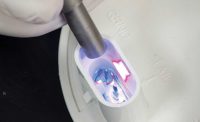Many adhesives cure just fine at room temperature. Other formulations do better with heat.
Epoxies and urethanes are the most common chemistries used in heat-cure applications. However, other adhesives, such as acrylics or methacrylates, can be negatively affected by higher temperatures during the cure process and are less likely to use heat.
Benefits of heat curing include greater bond strength, hardness, rigidity, toughness and impact resistance. Chemical resistance, thermal resistance and electrical insulation performance can also improve with heat. On the other hand, flexibility, elongation and crack resistance may be reduced as a result of heat exposure.
“Adding heat when curing adhesives improves cross-linking density,” says Utsav Shah, technical support engineer at Master Bond Inc. “This, in turn, provides improved adhesive performance. Typically, one-component epoxy systems require a heat cure.”
Engineers use heat to speed up the adhesive curing process. “Most two-component adhesives will cure at room temperature, but many of these will have much faster cure times with the addition of heat,” notes Paul Brown, technical service engineer at Lord Corp. “Curing adhesives with heat can reduce cycle times and greatly increase throughput.”
“Depending on the adhesive chemistry, heat curing can increase temperature resistance, chemical resistance and improve the strength of the adhesive, especially at elevated temperatures,” says Mark DeLaForest, marketing manager for structural adhesives at 3M Co. “Higher cross-link densities, as well as more complete polymerization, are usually benefits to heat curing.”
Heating Devices
Epoxies and other adhesives can be heated with a variety of devices ranging from infrared lamps to convection ovens.
“The most common method is a conventional oven,” says Edgardo Rodriguez, director of sales and marketing at Hernon Manufacturing Inc. “But, use of industrial convection ovens is on the rise. Induction heating is also gaining popularity, especially for military applications.”
Other potential heat sources include platens, hot air impingement, infrared lamps and ceramic heaters.
“The heat source often is substrate dependent,” Brown points out. “Platen heat is common and efficient. It has direct contact with the substrate and transfers quickly into the adhesive layer.
“Induction heat can be used with metal substrates or if the adhesive is formulated with iron,” adds Brown. “Induction units heat the metal very quickly, but they are expensive and can be difficult to control. Ovens are used for some applications, but are less efficient. They waste energy and take up a lot of floor space.
“The greatest challenge is designing heated fixtures that can transfer heat through the substrate and into the adhesive layer efficiently,” claims Brown. “Getting heat into the adhesive layer quickly is key to creating strength quickly and reducing cycle times.”
According to DeLaForest, industrial convection ovens remain a popular device for curing adhesives. Many engineers prefer a tunnel configuration where parts pass through the oven for a short period of time.
“However, infrared and similar types of heat lamps are becoming more common, especially for smaller parts,” says DeLaForest. “Microwave and other forms of radiation curing can also be used, but these are generally not considered heat-curing devices.”
No matter what type of heating device is used, it’s always important to use the correct amount of heat.
“With many chemistries, you can cure for a shorter amount of time with a higher temperature,” notes DeLaForest. “But, it has limits. If you exceed a certain temperature, you will degrade the adhesive and it will not cure properly.”
“Many epoxy-based adhesive systems are designed to cure at 150 C within approximately 20 to 30 minutes, although full cure may be achieved at temperatures as low as only 100 C,” says Darryl Small, senior market application engineer at Henkel Adhesive Technologies. “The general rule of thumb is that every decrease of 10C in oven temperature requires cure time to double in duration. And, every 10C increase in oven temperature reduces cure time duration by half.
“Few epoxies are formulated to cure at temperatures lower than 100C, since these are generally less shelf-life stable when stored for weeks or months before use,” adds Small. “Although some higher performance epoxies require up to 200C to cure, this is usually not desirable, as it decreases operator safety and increases energy costs.
“In addition, many polymers are not thermally stable at temperatures exceeding 200C, resulting in burning and degradation of the polymer matrix,” warns Small. “This is the No. 1 challenge associated with induction heat-cure technology, which is traditionally used on metals and ceramics.”
Heat curing is dependent upon both temperature and time. “It is very important to provide the appropriate amount of heat and the appropriate amount of time,” DeLaForest points out. “If the adhesive is not cured at a high enough temperature for a long enough period time, it could result in failure.”
Diverse Applications
Adhesives that require heat curing are used in a variety of applications, including automotive, aerospace, electronics, medical, and the oil and gas industries.
“Traditionally, heat curing has been primarily used in the transportation sector, including aerospace and automotive,” says DeLaForest. “But, advancements in materials and adhesives have enabled other industries, such as sporting goods, medical devices and electronics, to use heat curing.
“Demand for heat curing hasn’t diminished over the past decade, but advancements in two-part, room-temperature curing and radiation curing have enabled these technologies to grow faster than heat curing,” adds DeLaForest. “More recently, heat curing or heat bumping is being used in high-volume, high-speed assembly operations.”
Heat curing is often used for higher value devices and critical safety applications, such as composites or metals in which the potential cost of failure is extremely high.
“Heat cure is often the most reliable method to ensure full cure, and the method that provides the greatest bond strengths,” says Small. “Many room-temperature-curing adhesives exhibit higher bond strengths when subjected to heat, as long as the heat does not exceed the upper temperature limit for the assembly.”
Automotive parts that are bonded with heat include magnets attached to motor cans on fractional horsepower motors, such as cooling fans in engines and HVAC motors for the interior of cars. Rubber parts are also bonded with heat curing, such as products that contain a mix of steel and rubber pieces.
In the electronics industry, parts are surface mounted to FR4 circuit boards using heat-cure adhesives. “Potting compounds are heat-cure adhesives used to conceal (for proprietary reasons) or ruggedize (for environmental or durability reasons) the components,” Small points out.
However, Small says demand for heat-cure applications is not increasing, primarily because the energy costs associated with providing heat is not consistent with industrywide objectives of lowering overall manufacturing costs.
“Heat-curable epoxies are still widely available, but most companies are looking to decrease their overall costs to manufacture, especially time requirements,” claims Small. “Room-temperature curing and two-part mix adhesives are more favorable today.”
Although some heat-cure systems require several hours at temperature, most require 30 to 60 minutes to achieve full properties. “Of course, this does not include the time required to reach the curing temperature, or the time required to cool down for future handling,” notes Small.
While heat curing offers advantages, it can create headaches and challenges for engineers.
“Heat curing increases the amount of adhesive cross linking, which can increase the shear strength of the joint,” says Small. “However, increased cross linking can also make the joint more rigid with less flexibility and impact resistance.
“The bigger issue is that bringing the entire part up to the required temperature adds process time,” adds Small. “Once the time at temperature is achieved to cure the material, the part needs time to cool down to room temperature for further processing.
“This adds considerable work-in-process inventory, which has two main consequences: a significant amount of floor space is required to inventory parts, and quality checks cannot be completed until a significant amount of inventory has been assembled,” warns Small. “This time lag raises the potential for large amounts of parts to have to be scrapped if a defect is encountered.”







